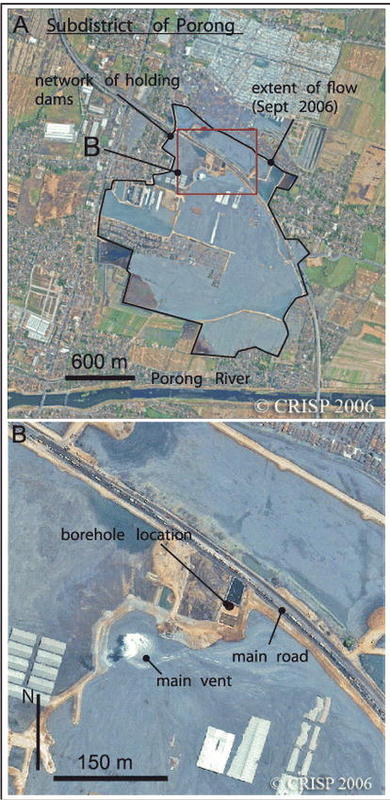(Reposted – with an update – from ye olde blog)
The latest from Lusi
In May 2006, an exploratory gas well being drilled in eastern Java hit a limestone aquifer. Because the lower part of the well had not yet been ‘cased’ – sealed off from the surrounding rock – a surge of overpressured water was released into the mudstones higher in the borehole, fracturing them and mixing them into a hot mud which eventually made its way to the surface near the drilling rig.
Since then, since then, 7,000-150,000 cubic metres of mud (up to 40 olympic swimming pools’ worth, in media units) a day has been disgorged from a vent dubbed ‘Lusi’, burying surrounding villages. I found this video on You Tube showing the encroachment of the mud – a rising tide which shows no sign of stopping.
From a more elevated perspective, here’s a satellite image. I think those huts on the bottom left of the second panel are the ones you see at the end of the video.

This is from a recent GSA Today paper by Davies et al.[doi], which confirmed that the drilling into the aquifer was probably responsible for the eruption; the company operating the well (understandably) tried to implicate an earthquake which occurred two days beforehand, but any seismogenic effects should have been immediate (and detectable as a pressure change in the borehole), and ‘liquefaction‘ tends to affect less cohesive sands more than mud.
You can read more on this at PhysOrg. Then read how they’re planning to put a stop to it:
Indonesian geophysicists hope to stem the flow of a destructive mud volcano on East Java by dropping chains of concrete balls into its mouth…
… Last week, the government team tackling the disaster approved a plan that will use 1,000 steel chains to try to slow the flow of mud. Each chain is 1.5 metres long and links together four concrete balls — two that are 40 centimetres across and two that are 20 centimetres across. Each ball and chain set will weigh about 300 kilograms. The balls themselves will be modified to maximize their friction with the mud.
Apparently, they think this will restrict the flow without just causing it to divert somewhere else. I suppose it depends on how fractured the rock is, but I’d say it’s a long shot at best.
Update: And, a month later, this rather bizarre plan swings into action. On Saturday, they only managed to drop one chain because a steel cable on the hoisting mechanism broke. They managed sixteen more on Monday, but then they hit another potential snag when they looked at the telemetry from sensors attached to the chains, as another site has reported under the arresting title ‘Volcano consumes concrete balls’:
The balls slid one kilometre into the crater, roughly twice the depth anticipated, so many more than planned may be required to staunch the mudflow, said the operation’s spokesperson Rudi Novrianto.
“Based on our monitoring of Monday’s operations, we may later decide to add to the number of ball chains, but the decision will only be made once the initial target of 374 chains have been dropped into the mud hole,” he said…
…Basuki Hadimuljono, the head of the team trying to plug the steaming crater, was quoted by the Koran Tempo newspaper as saying that the number of chains required may rise to 1 000 from the initial estimate of 374.
I remain unconvinced that this is going to work, but you can’t fault their perseverance.
(Thanks to Geology News for the heads-up which led to the update).
Categories: geohazards, geology, Lusi



Comments (4)